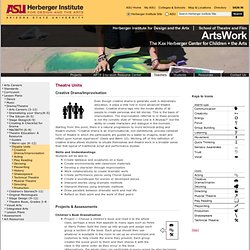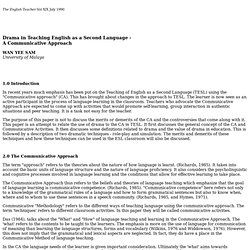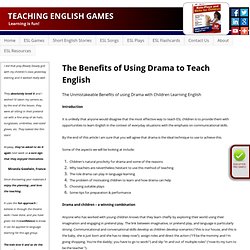

ASU Herberger Institute for Design and the the Arts. Creative Drama/Improvisation Even though creative drama is generally used in elementary education, it plays a vital role in more advanced theatre studies.

Creative drama taps into the innate ability of all people to create personas and tell stories. This is the basis of improvisation. The improvisation referred to in these projects is not the comedic style of "Whose Line is it Anyway? " but the ability to create characters and dialogue in the moment. Skills and Understandings Students will be able to: Create tableaux and sculptures on a topic Create environments with classroom materials Develop a character through improvisation Work collaboratively to create dramatic work Create performance pieces using Choral Speak Create a soundscape for scenes or developed pieces Interpret stories using dramatic methods Interpret themes using dramatic methods Draw parallels between dramatic work and real life Reflect on their work and the work of their peers Projects & Assessments Modern Fairy Tale. Children's Theatre/Creative Drama Menu.
Cliick below for free script. Free Teen Monologues for One Actor (teenager high school scripts) #acting for auditions, stage, performance, workshop. Acting Exercises: For High School Students and Beginners. Here are a few acting exercises you can use to sharpen up your craft.

Some of them are simple theatre games, while others are more complex. All of them are designed to help your acting abilities. Please note: Some of these acting exercises require the use of a character. Go read a play that you've never heard of and choose a character that interests you. Middle and High School Alphabet SceneTwo students are selected. For example: If Y is the letter chosen, the first line of the scene starts with Y. If you want to make it harder, add more actors. Why? Zip Zap ZopGather everyone into a circle.
Why? Freeze! Why? Question SceneTwo students improvise a scene where the all lines must be questions. Why? Backwards SceneTwo students are selected. Why? Party QuirksOne student plays the host of the party. Why? College Level Public SolitudeThe student will play out their morning routine in the studio as if they were alone. Why? "Stop looking at my shirt! " "Stop looking at your shirt? " And so on. One-Act Plays: Dramas. Flexible Cast Plays. Lesson Plans. * Suggest new websites, blogs, wikis, nings... to add. * Submit your own websites, blogs, wikis, nings... * Let me know if any of the links you find here are broken. * Recommend the site on blogs, forums and other sites. * Link this site. * Consider buying my 1,000 Ideas and Activities book. School Radio - Primary Drama: Teaching resources for KS2 and KS1 drama lessons.
Welcome to the Raven Radio Theater. Main8. The English Teacher Vol XIX July 1990 Drama in Teaching English as a Second Language - A Communicative Approach WAN YEE SAMUniversity of Malaya 1.0 Introduction In recent years much emphasis has been put on the Teaching of English as a Second Language (TESL) using the "Communicative approach" (CA).

This has brought about changes in the approach to TESL. The purpose of this paper is not to discuss the merits or demerits of the CA and the controversies that come along with it. 2.0 The Communicative Approach The term "approach" refers to the theories about the nature of how language is learnt. The Communicative Approach thus refers to the beliefs and theories of language teaching which emphasize that the goal of language learning is communicative competence. Communicative "Methodology" refers to the different ways of teaching language using the communicative approach. Das (1984), talks about the "What" and "How" of language teaching and learning in the Communicative Approach. 1. 2. 3. 4. The Benefits of Using Drama to Teach English. The Unmistakeable Benefits of using Drama with Children Learning English Introduction It is unlikely that anyone would disagree that the most effective way to teach ESL children is to provide them with opportunities to learn English in the context of everyday situations with the emphasis on communicational skills.

By the end of this article I am sure that you will agree that drama is the ideal technique to use to achieve this. Some of the aspects we will be looking at include: Children's natural proclivity for drama and some of the reasonsWhy teachers are nevertheless hesitant to use this method of teachingThe role drama can play in language learningThe problem of motivating children to learn and how drama can helpChoosing suitable playsSome tips for preparation & performance Drama and children – a winning combination Anyone who has worked with young children knows that they learn chiefly by exploring their world using their imagination and engaging in pretend play.
The WWW Virtual Library for Theatre and Drama. Telling Stories: ESL Strategies Drama Page. Drama in the ESL Classroom - Home.